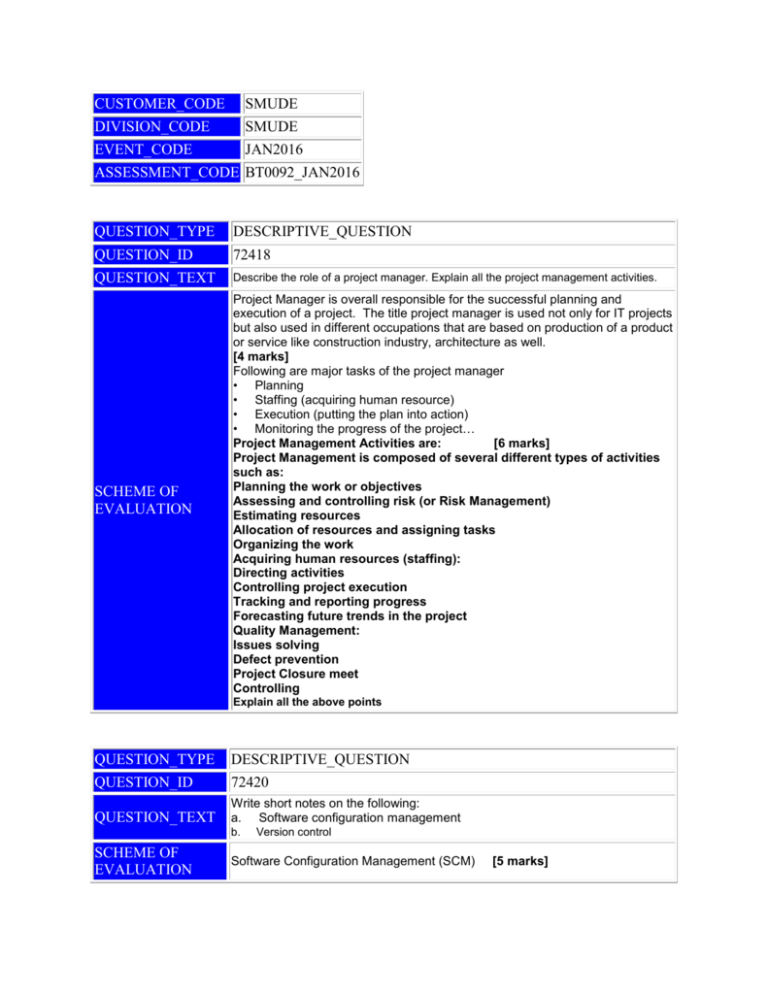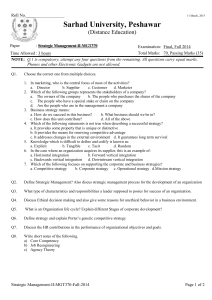CUSTOMER_CODE SMUDE DIVISION_CODE SMUDE
advertisement

CUSTOMER_CODE SMUDE DIVISION_CODE SMUDE EVENT_CODE JAN2016 ASSESSMENT_CODE BT0092_JAN2016 QUESTION_TYPE DESCRIPTIVE_QUESTION QUESTION_ID 72418 QUESTION_TEXT Describe the role of a project manager. Explain all the project management activities. SCHEME OF EVALUATION Project Manager is overall responsible for the successful planning and execution of a project. The title project manager is used not only for IT projects but also used in different occupations that are based on production of a product or service like construction industry, architecture as well. [4 marks] Following are major tasks of the project manager • Planning • Staffing (acquiring human resource) • Execution (putting the plan into action) • Monitoring the progress of the project… Project Management Activities are: [6 marks] Project Management is composed of several different types of activities such as: Planning the work or objectives Assessing and controlling risk (or Risk Management) Estimating resources Allocation of resources and assigning tasks Organizing the work Acquiring human resources (staffing): Directing activities Controlling project execution Tracking and reporting progress Forecasting future trends in the project Quality Management: Issues solving Defect prevention Project Closure meet Controlling Explain all the above points QUESTION_TYPE DESCRIPTIVE_QUESTION QUESTION_ID 72420 QUESTION_TEXT Write short notes on the following: a. Software configuration management b. SCHEME OF EVALUATION Version control Software Configuration Management (SCM) [5 marks] Software configuration management (SCM) is an umbrella activity that is applied throughout the software process. Because change can occur at any time, SCM (software configuration management) activities are developed to (1) Identify change (2) Control change (3) Ensure that change is being properly implemented (4) Report changes to others who may have an interest… Version control combines procedures and tools to manage different versions of configuration objects that are created during the software process. Clam describes version control in the context of SCM as follows: Configuration management allows a user to specify alternative configurations of the software system through the selection of appropriate versions. This is supported by associating attributes with each software version, and then allowing a configuration to be specified [and constructed] by describing the set of desired attributes. These "attributes" mentioned can be as simple as a specific version number that is attached to each object or as complex as a string of Boolean variables (switches) indicating specific types of functional changes that have been applied to the system. [5 marks] QUESTION_TYPE DESCRIPTIVE_QUESTION QUESTION_ID 72422 QUESTION_TEXT Explain software reengineering process model. SCHEME OF EVALUATION Software Reengineering Process Model [ 10 marks] Reengineering takes time; it costs significant amounts of money; and it absorbs resources that might be otherwise occupied on immediate concerns. For all of these reasons, reengineering is not accomplished in a few months or even a few years. Reengineering of information systems is an activity that will absorb information technology resources for many years. That’s why every organization needs a pragmatic strategy for software reengineering. A workable strategy is encompassed in a reengineering process model. We’ll discuss the model later in this section, but first, some basic principles. Reengineering is a rebuilding activity, and we can better understand the reengineering of information systems if we consider an analogous activity, the rebuilding of a house… Six Activities of Software Reengineering Process are: Inventory analysis Document Restructuring Reverse engineering Code restructuring Data restructuring Forward engineering Explain all the above points. QUESTION_TYPE DESCRIPTIVE_QUESTION QUESTION_ID 125843 QUESTION_TEXT Define CASE. List and explain the various categories of CASE tools. The term Computer Aided Software Engineering (CASE) is applied to software products development that uses extensive software engineering principles and these processes are implemented either partly or majorly through the supporting software. The CASE tools can be broadly categorized as follows SCHEME OF EVALUATION • Information Engineering supporting products • Structured diagramming supporting products • Structured development aids providing products • Application code generating products (10 marks) QUESTION_TYPE DESCRIPTIVE_QUESTION QUESTION_ID 125844 QUESTION_TEXT Briefly explain the various potential risk treatment categories. Solution: The various potential risk treatment categories are: (Brief explanation for each is needed) SCHEME OF EVALUATION Avoidance 3 Marks Reduction 3 Marks Sharing 2 Marks Retention 2 Marks QUESTION_TYPE DESCRIPTIVE_QUESTION QUESTION_ID 125848 QUESTION_TEXT What is software testing? Briefly explain the different types of software testing techniques used. Solution: Software testing is the process of running through the application or a software product with the intention of uncovering the errors. It is the mechanism by which one can ascertain that the product meets its intended specifications. (2 Marks) Types of software testing include: (Brief explanation for each needed) Functional testing SCHEME OF EVALUATION Forced error testing Compatibility testing Performance testing Scalability testing Stress testing Usability testing Application testing Marks) (1 x 8 = 8






